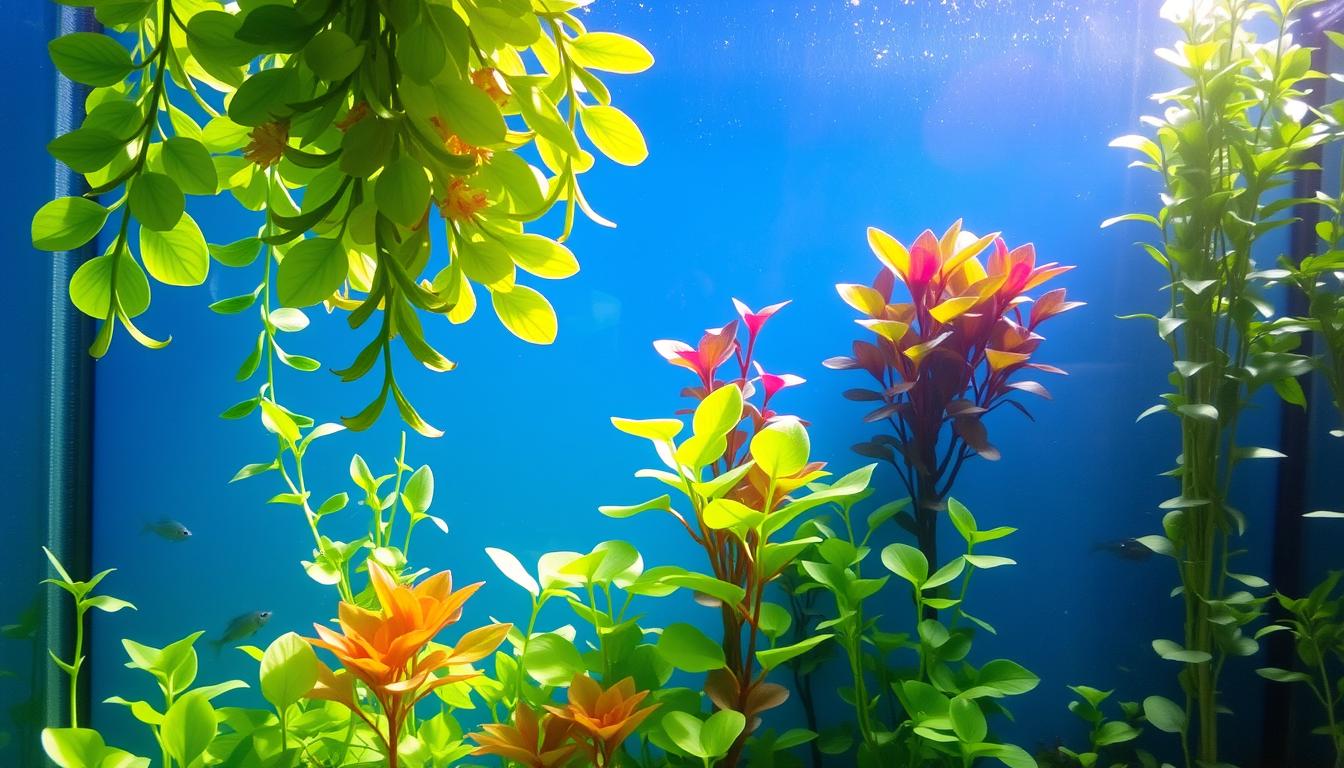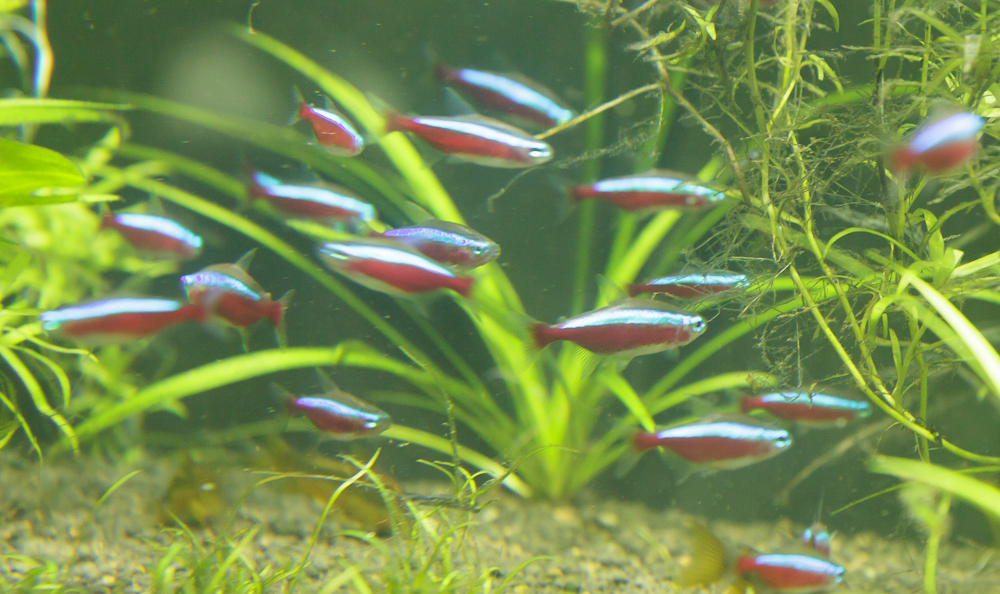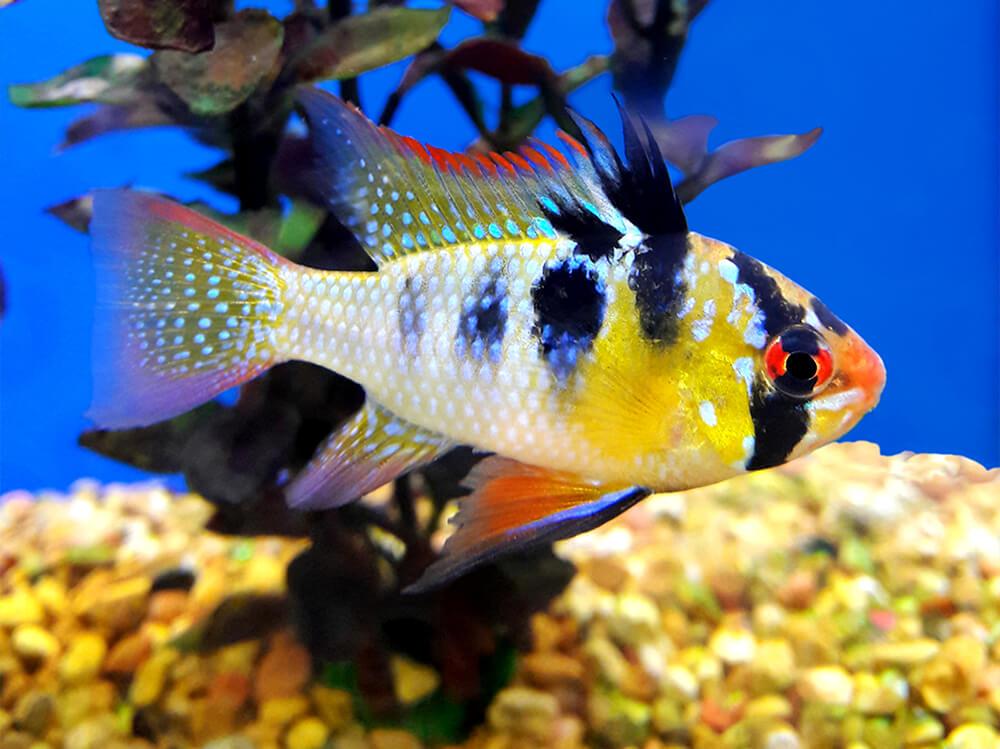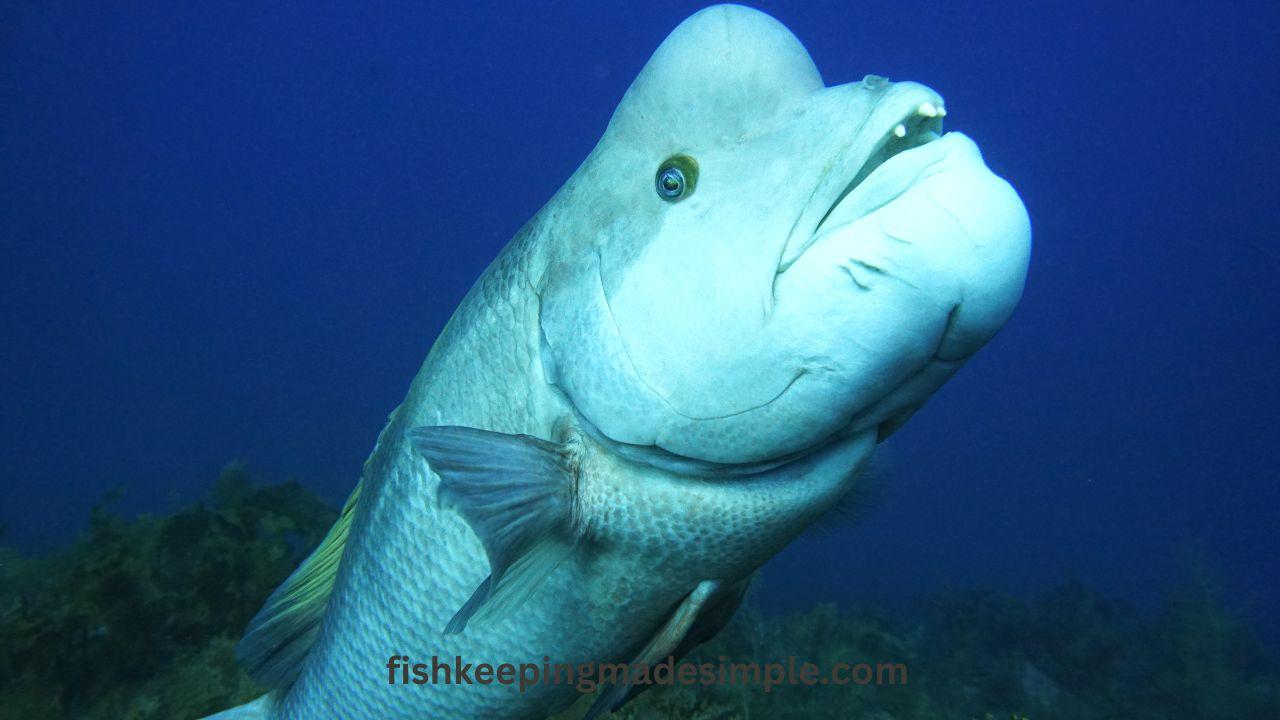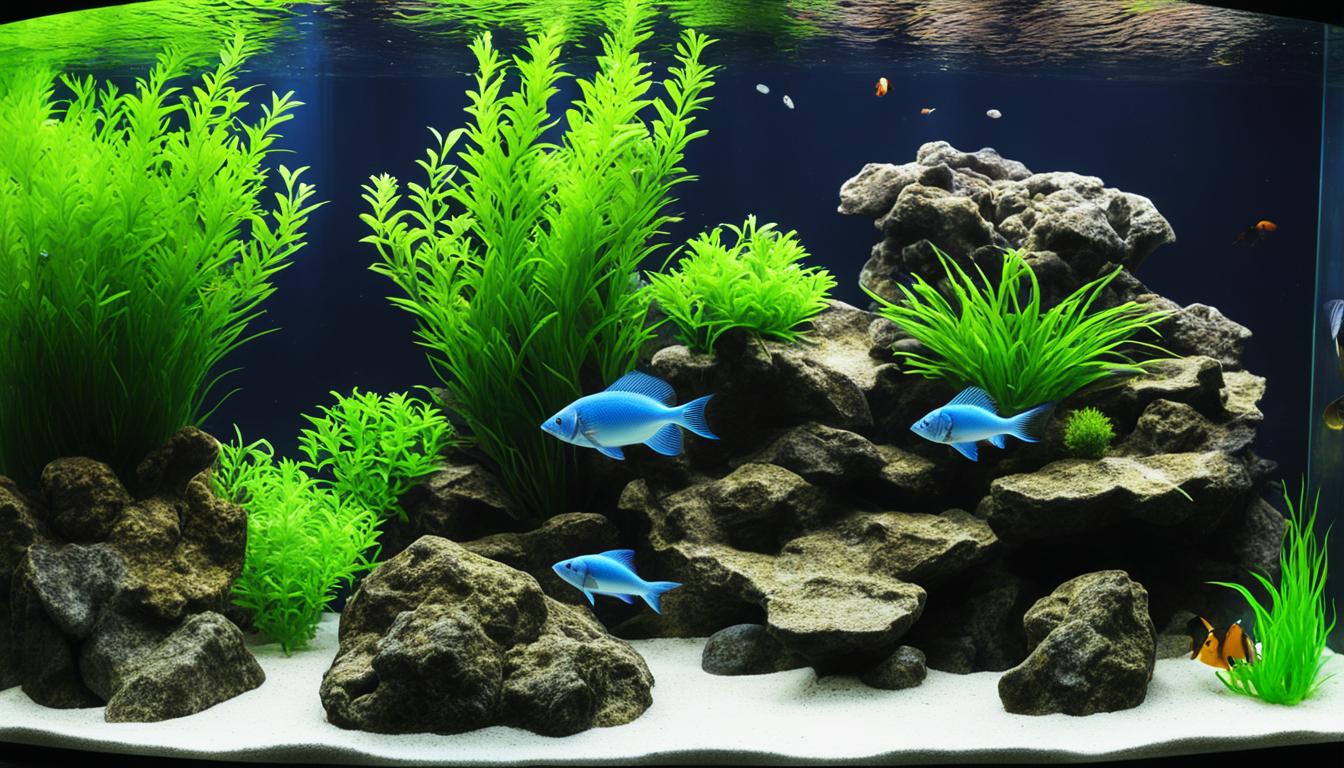Did you know the common Duckweed can quickly cover your fish tank’s surface? It grows fast, reducing nitrates and feeding smaller fish. These floating plants are diverse and useful, from the big Water Lettuce to the delicate Water Spangles.
They’re not just for looks; they help with oxygen and give fish a place to hide. I find them fascinating for turning a tank into a lively underwater world. They act as natural filters and food sources, making your tank a healthy home for fish.
It’s important to know what plants like. For example, the Dwarf Water Lily thrives in many temperatures, but the Banana Lily likes its space. Understanding their needs helps you create a balanced tank.
Table of Contents
Key Takeaways
- Common Duckweed plays a crucial role in nitrate reduction and serves as a food source in tanks.
- Water Lettuce and Water Spangles are praised for their size and oxygenation capabilities.
- Dwarf Water Lily is versatile, while the Banana Lily is a space-conscious beauty.
- Floating aquarium plants significantly impact tank oxygenation and provide essential shelter for fish.
- The importance of selecting the right floating plants to ensure compatibility with herbivorous fish species.
- Regular monitoring and maintenance are key to sustaining the beauty and health of floating plant species.
- Patience is essential, as floating plants require time to acclimate and establish themselves in new aquarium settings.
The Enchanting World of Floating Aquarium Plants
Floating aquarium plants bring underwater beauty to our homes. They play both an aesthetic and ecological role in our tanks. These plants help create a natural home for fish, reduce stress, and improve water quality. This makes them key to a healthy aquatic life.
These plants look amazing in an aquarium. With species like Duckweed, Water Lettuce, and Hornwort, each adds its own touch to the tank. They turn a simple tank into a vibrant underwater world. These plants float on the water, creating a lush canopy that looks just like their natural habitats.
Through photosynthesis, these plants make the tank a better place for fish and other creatures. They take in nutrients like nitrates and phosphates, stopping algae from growing. This keeps the water clear and healthy for all living things.
| Plant Species | Benefits | Visual Appeal |
|---|---|---|
| Duckweed | Excellent nutrient absorber; provides extensive cover | Provides a green velvet-like surface |
| Water Lettuce | Forms dense rosettes; oxygenates water efficiently | Velvety, light green leaves |
| Hornwort | Aids in oxygen release; reduces algae growth | Lush, feather-like foliage |
| Frogbit | Creates shelter; competes with algae for nutrients | Round, lily pad-like leaves |
| Salvinia | Oxygenates water; traps air with leaf structures | Small, floating fern leaves form dense mats |
These plants are crucial for shy or small fish and their babies. They give them a safe place to hide from bigger fish and bullies. This lowers stress in the tank and helps fish act naturally.
Choosing the right plants depends on your tank size, fish type, and how much you can maintain it. But, their benefits like better water quality and looks make them a top choice for all aquarists.
Adding underwater plants to your aquarium is more than just decoration. It’s about making a sustainable, natural home for your fish. Floating plants are true wonders that bring nature indoors, adding peace and beauty to our homes.
Creating the Perfect Habitat with Aquatic Plant Care
To get aquatic plants to thrive, it’s key to know the basics of their care. This means creating the right environment with the right amount of light, filtration, and nutrients.
Promoting Healthy Plant Growth
Aquatic plants are crucial for keeping aquariums balanced. They clean the water and make oxygen through photosynthesis. For the best growth, balance light and nutrients well. This stops algae from taking over and competing with plants.
Keeping up with maintenance like trimming and planting is vital. It lets each plant get enough space and resources. This way, they help with filtration and make the tank look better.
The Importance of Light and Filtration
Light and filtration are key for a good home for aquatic plants. Plants need light for photosynthesis, the way they make energy. Different plants need different light levels, so it’s important to get it right to avoid too much algae.
Filtration keeps the water clear and healthy and helps plants by removing bad stuff and spreading good nutrients. A good filter makes a big difference for plant care.
With the right light and filter, aquatic plants will be healthier and look better. This makes the aquarium more lively and colorful.
| Plant Type | Light Requirement | Growth Rate | Additional Benefits |
|---|---|---|---|
| Water Lettuce (Pistia stratiotes) | Moderate | Fast | Shades lower levels, reducing algae |
| Amazon Frogbit (Limnobium laevigatum) | Low to Moderate | Medium | Absorbs excess nutrients, improving water quality |
| Duckweed (Lemna minor) | Low | High | Acts as a natural water filter |
| Salvinia (Salvinia natans) | Low to High | Fast | Provides dense shade, controlling algae growth |
| Red Root Floaters (Phyllanthus fluitans) | High | Medium | Enhances oxygenation and aesthetics |
The Best Floating Plants for Your Aquarium
Exploring the best floating plants for aquariums shows us their value. They add beauty and help keep the water healthy. Choosing the right plants is key for a thriving aquarium.
Salvinia Minima: A Rapid Grower
The water sprite, Salvinia Minima, is loved for its fast growth and adaptability. It can grow a lot in a short time with the right conditions. This plant makes your aquarium look great and helps keep the water balanced by adding oxygen and shelter for fish.
Azolla Filiculoides: The Pest Controller
Azolla Filiculoides is a top choice for best floating plants for aquarium. It controls pests by living with algae that stops unwanted algae growth. It also cleans the water by changing nitrogen into something good for plants.
| Floating Plant | Light Requirement | CO2 Requirement | Growth Rate |
|---|---|---|---|
| Salvinia Minima | Medium to High | Low to Moderate | Rapid |
| Azolla Filiculoides | Low to Medium | Low | Moderate to Fast |
| Water Sprite | Medium to High | Moderate | Fast |
Salvinia Minima and Azolla Filiculoides are vital for your aquarium. They provide shade and help create a healthy environment. Their fast growth and specific needs make them great for all aquarists.
Benefits of Adding Floating Plants to Your Aquatic Paradise
Adding floating plants to your aquarium makes it a true aquatic paradise. These plants are key for the tank ecosystem. They also add beauty and create a calm space for fish.
Floating plants like Amazon Frogbit and Water Lettuce offer natural shelter. They give fish safe places and lower stress. Salvinia and Duckweed form thick mats that block too much light. This helps fish and plants stay healthy.
These plants are also important for the tank’s nutrition. Water Hyacinth and Red Root Floater take up nutrients, stopping algae from growing. This keeps the water clear and healthy for all living things.
- Java Moss and Hornwort: They help make the water oxygen-rich, which is good for the tank’s health.
- Water Sprite and Water Pennywort: These plants grow fast and help control the water’s balance. They absorb nitrates and provide shade.
Adding these plants makes your aquarium better in many ways. It becomes a lively, self-sustaining place. It’s great for both new and experienced aquarium owners.
Using floating plant benefits makes your aquarium more lively and beautiful. It turns your tank into a magical underwater garden. It’s a key step for anyone wanting a better aquarium.
Maintaining the Delicate Balance of Floating Vegetation
Exploring aquatic ecosystems shows us how vital floating vegetation is. These plants need a balance of light and nutrients to stay healthy. This balance is key for their growth and helps them absorb nutrients well.
The Role of Lighting in Plant Health
Lighting is crucial for floating plants. It makes the aquarium look good and helps plants grow by supporting photosynthesis. Too much light can lead to too much algae, so I keep the lighting at 6-8 hours a day. This way, plants like Water Wisteria and Water Sprite get enough light to grow without letting algae take over.
Control of Nutrient Levels for Plant Sustenance
Keeping the right amount of nutrients in the water is also important. Plants like Duckweed and Salvinia grow fast and take in nitrates, which helps keep the water balanced. By checking and adjusting the water, these plants can keep doing their job well. Adding fish and shrimp that eat algae helps keep the water clean and healthy.
| Plant Species | Nutrient Consumption | Impact on Algae Control |
|---|---|---|
| Water Wisteria | High nitrate absorption | Reduces algae by competing for nutrients |
| Duckweed | Effective nitrate absorber | Prevents excessive algae growth |
| Salvinia | Consumes nitrate and phosphate | Minimizes surface algae |
It’s important not to let floating plants shade the submerged ones or upset the tank’s balance. Pruning them regularly lets in enough light and keeps the tank looking good. In the end, taking care of floating plants is a mix of science and art. It makes for a beautiful and healthy aquarium.
Aquarium Aesthetics: Selecting the Right Floating Plant Species
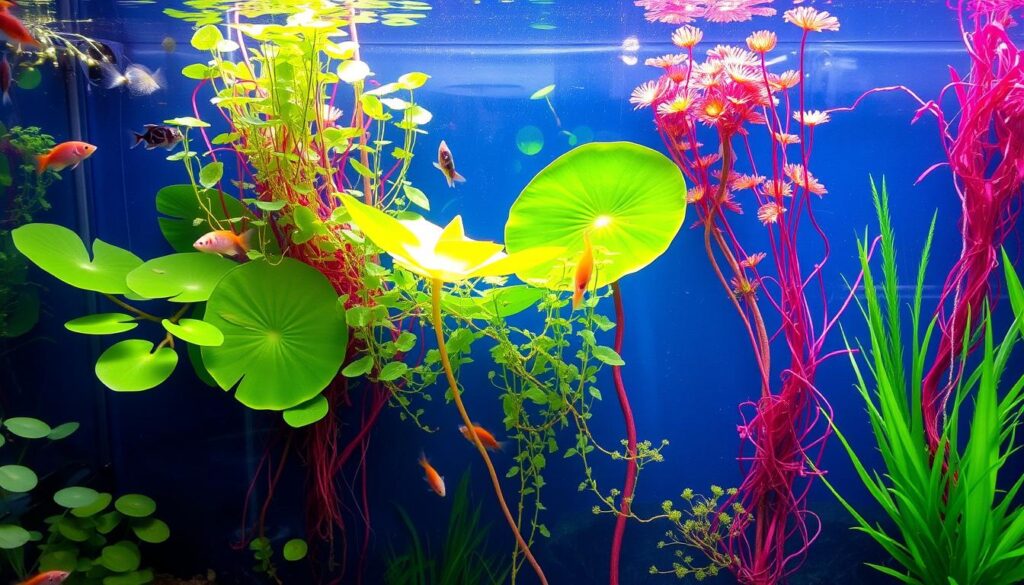
Choosing the right floating plants for your aquarium is more than just making it look good. It’s about picking plants that fit well with other plants and your fish. This careful selection helps create a balanced environment that supports your fish and looks great.
Finding Harmony with Aquatic Residents
When picking plants, think about how they help your fish and the tank’s balance. Plants like Duckweed and Water Lettuce grow fast and help keep the water clean. They take in bad stuff like nitrates and phosphates, which is key in tanks with lots of fish.
These plants also give fish a place to hide and feel safe. Species like Frogbit and Salvinia have leaves that make great hiding spots. This helps fish breed and grow in a calm place.
Decorative Strategies for Floating Plant Placement
Where you put floating plants can really make your aquarium look better. Placing them right helps with light and nutrients, making your plants and fish happy. Tools like airline tubing keep plants in place and make sure light gets everywhere.
This way, plants like Duckweed don’t take over and block light. It’s all about finding the right balance for a healthy tank.
Choosing plants that work well together makes your aquarium look better. Plants like Red Root Floaters and Water Lettuce add different looks but fit together well. This mix creates a lively and beautiful underwater world.
Starting this journey of picking and placing plants can turn your aquarium into a masterpiece. It supports a healthy environment and makes your tank look amazing.
Advanced Floating Plant Maintenance Techniques
Looking after floating plants in an aquarium is more than just basic care. It means using advanced techniques like pruning, water quality monitoring, and managing aquatic health. These methods help your plants not just survive but thrive. They make your tank look better and keep the ecosystem balanced.
Pruning is key for keeping your floating plants healthy and looking good. Trimming them regularly stops them from taking over. This keeps enough light and oxygen in the tank for both plants and fish. Plus, removing dead leaves keeps the tank looking nice and healthy.
Water quality monitoring is vital for keeping your floating plants in top shape. Checking things like pH, nitrate, and phosphate levels helps you make the right changes. This keeps the water perfect for plants and fish, stops algae, and prevents other problems.
When adding new plants to your tank, do it carefully. Putting new plants in a separate area first can protect against pests and diseases. This is key for keeping your tank balanced and healthy for a long time.
Here’s a look at how different floating aquarium plants grow and spread:
| Plant Type | Invasive Status | Growth Rate | Compatibility |
|---|---|---|---|
| Water Lettuce | Classified as invasive in several states | High | Easy to propagate |
| Java Moss | Not typically invasive | Moderate | Extremely hardy |
| Water Wisteria | Considered ‘can’t-kill-it’ due to hardiness | Fast | High adaptability |
| Water Sprite | Can be floated or planted | Fast | Beginner-friendly and attractive to fish fry |
To sum up, taking good care of your floating plants means pruning, checking the water quality, and keeping an eye on health. With these efforts, your plants will do well and make your aquarium look and feel better.
Combining Beauty and Function: Floaters with Submerged Plants
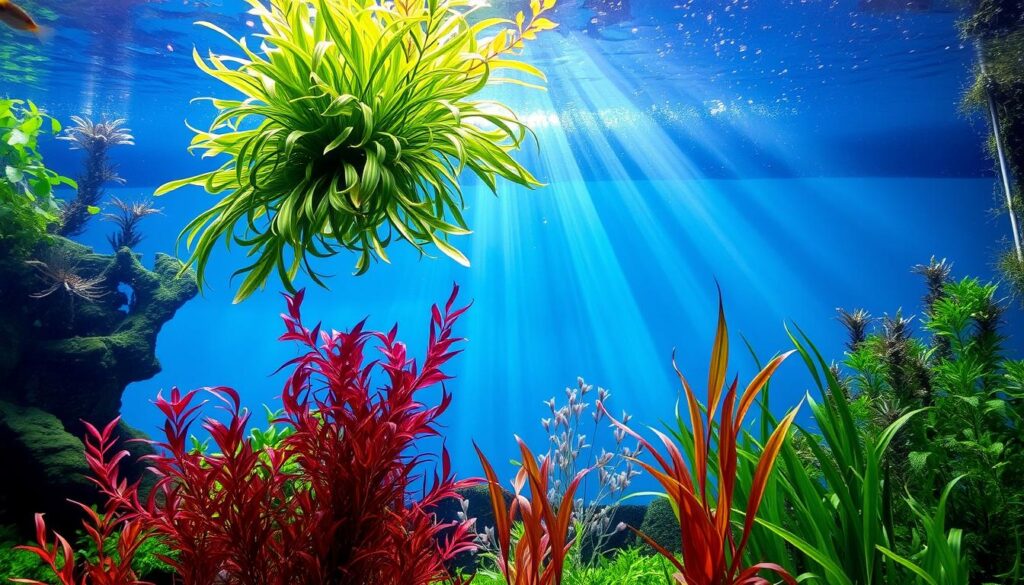
In the world of aquarium design, mixing floating and submerged plants boosts both function and beauty. This method, called combined aquascaping, uses both types of plants to create a balanced, healthy, and beautiful ecosystem.
Floating plants like Water Lettuce and Duckweed are great for several reasons. They provide shade, which is key for underwater plants that need less light. This shade helps stop algae from growing, keeping the water clear and healthy for all water plants.
Floaters and submerged plants work together to improve oxygen levels and nutrient cycling in the tank. The floating plants make oxygen and use up extra nutrients, which stops algae from taking over. This is vital for the health of fish and other water creatures, making the tank a better place for them.
- Floating plants absorb excess nutrients, reducing algae.
- Oxygen production from photosynthesis supports aquatic life.
- The dense cover of floaters provides safety and stress reduction for fish and fry.
Aquariums with both floating and submerged plants look amazing. They can make your tank look like a real underwater scene. This not only looks good to us but also helps fish act naturally, keeping them happy and healthy.
| Plant Type | Benefits | Ideal Position in Tank |
|---|---|---|
| Water Lettuce | Shades submerged plants, absorbs nutrients | Surface |
| Duckweed | Controls algae, oxygenates water | Surface |
| Hornwort | Provides oxygen, shelters aquatic life | Submerged |
| Frogbit | Enhances aesthetics, provides shade | Surface |
Using combined aquascaping is more than making your aquarium look good. It’s a smart way to keep your tank healthy. By understanding how different water plants work together, you can create a space that’s both lovely and good for the fish.
A Natural Haven for Your Tank’s Inhabitants
Floating water plants make your aquarium look great and play a big role. They give fish a safe place to hide and help show how healthy the plants are. Let’s see how these plants help keep fish safe and the water clean.
Floating Plants as a Shelter for Fish and Fry
Floating plants like Salvinia Minima are perfect for fish, especially tiny fry. They hide fish from predators and let them move around safely. This helps fish feel less stressed and live longer.
The Health Indicators of Aquatic Plants
Watching your water plants can tell you a lot about your tank’s health. Healthy plants mean good water and the right nutrients. If plants start to look bad, it might mean you need to check the water quality.
Let’s look at some real data collected from discussions among aquarium enthusiasts to understand better how various factors influence the health and growth of floating aquarium plants:
| Issue | Impact on Plant Growth | Possible Solutions |
|---|---|---|
| Zinc Levels | High levels can toxic to plants | Regular water testing and changes |
| Nutrient Variability | Uneven growth across different tanks | Consistency in nutrient dosing |
| UV Sterilizers | Oxidation of important nutrients | Controlled use and monitoring of nutrient levels |
| Lighting & Ammonia | Can either boost or hinder growth | Ensuring adequate lighting and ammonia control |
Floating plants are more than just pretty in your fish tank. They are key for keeping fish safe and healthy. By watching the plants and keeping conditions right, you make your aquarium beautiful and healthy for all.
Conclusion
As an aquarium enthusiast, I’ve learned a lot about adding floating plants to my tank. These plants are not just decorations; they’re living parts of the underwater world. They help keep the tank balanced and support important bacteria that keep the water clean.
Floating plants have their own benefits, like getting plenty of CO2 from the air. This helps them grow strong and healthy. While it’s hard to say exactly how many floating plants to use, it’s clear that both floating and rooted plants are important together. They work together to keep the tank healthy, even without filters, as D. Walstead has shown.
Creating the perfect aquarium means thinking about looks and function. There are many types of floating plants, like duckweed and water lettuce, that add beauty and help with cleaning and oxygen. But, you need to think about the size of your tank, the light, temperature, and how much you can keep up with. With the right plants, your tank can become a beautiful, self-sustaining world under water.
FAQ
What are floating aquarium plants?
How do floating plants benefit the aquatic ecosystem in my tank?
What care do floating aquatic plants require?
Which floating plants are best for my aquarium?
How do I maintain the health of my floating plants?
Can I combine floating plants with submerged plants in my aquarium?
How do floating plants provide shelter in the aquarium?
Can floating plants indicate the health of my aquarium?
What maintenance techniques are important for floating plant care?
How do I select the right floating plant species for my aquarium?
I am a passionate aquarist with over 30 years of hands-on experience in fishkeeping. My journey began at a young age, collecting fish from the wild and learning through experimentation. Specializing in tropical fish, I bring a deep understanding of the hobby to FishKeepingMadeSimple. The site provides honest, detailed reviews of essential products and accessories to help fellow enthusiasts create the best environments for their fish.

